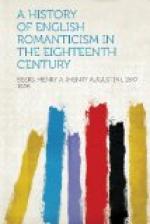And the farther such study is carried, the more evident it becomes that “mediaeval” and “romantic” are not synonymous. The Middle Ages was not, at all points, romantic: it is the modern romanticist who makes, or finds, it so. He sees its strange, vivid peculiarities under the glamour of distance. Chaucer’s temper, for instance, was by no means romantic. This “good sense” which Dryden mentions as his prominent trait; that “low tone” which Lowell praises in him, and which keeps him close to the common ground of experience, pervade his greatest work, the “Canterbury Tales,” with an insistent realism. It is true that Chaucer shared the beliefs and influences of his time and was a follower of its literary fashions. In his version of the “Romaunt of the Rose,” his imitations of Machault, and his early work in general he used the mediaeval machinery of allegory and dreams. In “Troilus and Cresseide” and the tale of “Palamon and Arcite,” he carries romantic love and knightly honor to a higher pitch than his model, Boccaccio. But the shrewdly practical Pandarus of the former poem—a character almost wholly of Chaucer’s creation—is the very embodiment of the anti-romantic attitude, and a remarkable anticipation of Sancho Panza; while the “Rime of Sir Thopas” is a distinct burlesque of the fantastic chivalry romances.[2] Chaucer’s pages are picturesque with tournament, hunting parties, baronial feasts, miracles of saints, feats of magic; but they are solid, as well, with the everyday life of fourteenth-century England. They have the naivete and garrulity which are marks of mediaeval work, but not the quaintness and grotesquerie which are held to be marks of romantic work. Not archaic speech, but a certain mental twist constitutes quaintness. Herbert and Fuller are quaint; Blake is grotesque; Donne and Charles Lamb are willfully quaint, subtle, and paradoxical. But Chaucer is always straight-grained, broad, and natural.
Even Dante, the poet of the Catholic Middle Ages; Dante, the mystic, the idealist, with his intense spirituality and his passion for symbolism, has been sometimes called classic, by virtue of the powerful construction of his great poem, and his scholastic rigidity of method.




